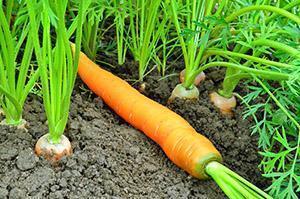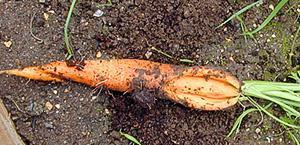Watering and feeding carrots
 Carrots are a tasty and healthy agricultural crop brought to our region from the Mediterranean coast more than 4000 years ago. The only vegetable to come from Europe to America, not the other way around.
Carrots are a tasty and healthy agricultural crop brought to our region from the Mediterranean coast more than 4000 years ago. The only vegetable to come from Europe to America, not the other way around.
Much has changed since the beginning of carrot cultivation: the root crop has “repainted” from purple to orange, which is familiar to everyone, has become sweeter and, unfortunately, “more capricious”. Now, in order to harvest a good harvest, gardeners should not only work hard, but also carefully study the basic rules of carrot care!
Read the article: urea as fertilizer!
Basic rules for watering carrots in the open field
Carrots are a sun-loving plant that is traditionally planted in sunny areas that are darkened for no more than two hours a day. It is not surprising that it needs to be watered often enough and abundantly:
Irrigation equipment

- The most suitable tool for watering carrots is a garden watering can: with a long and thin branch pipe and a medium diameter divider. It is better that the divider is removable - this can be cleaned from time to time or replaced with a new one.
- If the crops occupy a very large area, and there is no time to “tinker” with the watering can, you will need a high-quality hose: durable, flexible, kink-resistant, with a spray nozzle at the end.
Buckets are not at all suitable equipment for watering carrots. Do not use them in your garden, especially when it comes to young seedlings.
Watering seeds and first seedlings
During germination, carrot seeds absorb a lot of water - up to 100% of their own weight. Therefore, the garden bed prepared for them is moistened both before the start of sowing and after it. It is thanks to careful watering of the soil that it is possible to avoid excessive surface evaporation of moisture and the accompanying burning of young carrot tops.
Watering frequency and water consumption
 Watering young, immature carrot shoots is carried out quite often - every 3-4 days in hot weather. As the bushes grow, the frequency of watering is reduced: they are watered as the soil dries out, every 5-7 days (or so). Water consumption is, on average, 15 liters per 1 square meter.
Watering young, immature carrot shoots is carried out quite often - every 3-4 days in hot weather. As the bushes grow, the frequency of watering is reduced: they are watered as the soil dries out, every 5-7 days (or so). Water consumption is, on average, 15 liters per 1 square meter.
When thinking about how intensively and how often to water carrots, take into account the climatic conditions of your region, the type and quality of the soil, the proximity of groundwater, and other factors of this kind. The watering schedule given for an example is not the ultimate truth - it can increase or decrease.
Watering time
 Watering carrots is best done in the early morning. Watering in the evening will also not harm the plants (if the night is warm). It is recommended to refuse irrigation in the daytime. However, if this is unavoidable, water the carrots very carefully, so that splashes of water and dirt do not hit the stems and leaves.
Watering carrots is best done in the early morning. Watering in the evening will also not harm the plants (if the night is warm). It is recommended to refuse irrigation in the daytime. However, if this is unavoidable, water the carrots very carefully, so that splashes of water and dirt do not hit the stems and leaves.
Water temperature
Carrots also have certain requirements for water temperature. It is best that in hot weather it is slightly cooler (18 -22 ° C), on cloudy days - slightly warmer (25-30 ° C). It is recommended to refuse watering carrots in the open field with water, the temperature of which is less than 10 ° С.
Spraying
Spraying the carrots with salt water (or salt water with added lime) at night gives a good effect. It helps to get rid of slugs as well as some other pests.
The consequences of improper watering
 Weak watering leads to the growth of lateral shoots and other deformations of carrots. In fact, it grows not in depth, but in breadth, which means that it does not receive enough nutrients from the soil.
Weak watering leads to the growth of lateral shoots and other deformations of carrots. In fact, it grows not in depth, but in breadth, which means that it does not receive enough nutrients from the soil.
Excessive watering contributes to the spread of the fungus that causes various diseases in carrots. Waterlogging of the soil in combination with insufficient fertilization with nutrients is especially dangerous.
If the carrots have not been watered for a long time, and then decided to "catch up" at once, they can crack and lose the "lion's share" of their taste. Before watering the carrots after a long drought, it is recommended to slightly loosen the soil and moisten it with a little water for “training”.
Basic rules for feeding carrots in the open field
 In addition to watering, the main carrot care implies the timely application of fertilizers to the soil. Fertilization is necessary for a plant for full growth, nutrition, strengthening the immune system and increasing vitality. The health, taste, appearance and duration of storage of the crop will depend on how correct and timely the feeding was.
In addition to watering, the main carrot care implies the timely application of fertilizers to the soil. Fertilization is necessary for a plant for full growth, nutrition, strengthening the immune system and increasing vitality. The health, taste, appearance and duration of storage of the crop will depend on how correct and timely the feeding was.
So, how to feed carrots?
- Nitrogen. At the beginning of summer, carrots need nitrogen, a substance that is responsible for the growth of green mass and the formation of the ground part of plants. With a lack of nitrogen, the tops stop growing, the leaves shrink, lose their color intensity, turn yellow and die off. The fruits grow small and dry.
- Potassium. During intensive growth, carrots are extremely demanding potassium. Potash fertilizers not only provide normal plant photosynthesis, but also protect root crops from damage by all kinds of fungal and viral diseases. The lack of potassium can be determined by the short stature of the bush, the bronze shade, the browned tips of the leaves and the too strong development of the aboveground part of the carrot (developing to the detriment of the root crop).
 Phosphorus. On the hottest days, carrots need enough phosphorus. This substance is responsible for the regenerative properties and development of tissues. Lack of phosphorus can be easily identified by the appearance of the "patient". First, reddish or purple stripes appear on the leaves, then they completely change color, curl and dry out (a similar picture resembles a picture of a carrot fly defeat). The whole plant is stunted. Fruits are dwarf, weak, thin, with pointed (rather than rounded) ends. Their taste is not happy either.
Phosphorus. On the hottest days, carrots need enough phosphorus. This substance is responsible for the regenerative properties and development of tissues. Lack of phosphorus can be easily identified by the appearance of the "patient". First, reddish or purple stripes appear on the leaves, then they completely change color, curl and dry out (a similar picture resembles a picture of a carrot fly defeat). The whole plant is stunted. Fruits are dwarf, weak, thin, with pointed (rather than rounded) ends. Their taste is not happy either.- Manganese and Barium. Manganese and barium are the best ways to feed carrots and beets when root crops grow. The lack of these elements can be easily identified by white or red spots on the upper leaves and the dark (almost black) core of the root.
- Bor. In the middle of summer, feeding carrots in the open field consists in introducing boron. Boron is one of the most important trace elements for agricultural crops. It is responsible for the regulation of pollination, fertilization, protein and carbohydrate metabolism and, of course, the taste of the fruit (increases the amount of sugars). Boron deficiency can be identified by marginal and apical leaf necrosis. Yellowing of veins, inhibition of plant development and some other external signs are observed.
Which fertilizer should you choose?
Natural biostimulants suitable for feeding carrots are ash, mullein, compost, lime, nettle, decoctions of burdock and chamomile. However, the use of organic matter has a lot of disadvantages: the complexity of storage, preparation, calculation of the dosage of the solution, and so on. Often does more harm than good.Only those who are afraid of all kinds of "chemistry" should resort to organic fertilizers. He does not want to recognize her and likes to experiment.
Ready-made complex fertilizers, liquid fraction or granules, in turn, are very simple to use. And in terms of composition, they often significantly surpass organic matter.
Selection of mixtures suitable for carrots:
- nitrophos;
- nitroammophoska;
- ammophos;
- Kristalon;
- azophoska;
- Kemira;
- Solution.
Important nuances:
- In order to increase the "immunity" of carrots, it must be fed with potassium sulfate 10-14 days before harvesting.
- Before feeding the plants, the soil must be moistened with plain clean water.
- Top dressing of carrots is applied for each plant individually.
- Once every few years, the site must be lime. Lime is added at the rate of 0.4 kg / 1 square meter.
- Boric solution is introduced at the rate of 2-3 liters of mixture / 1 running meter.
- A solution of manganese and barium is prepared in a ratio of 1 teaspoon / 10 liters of water.
- Salt solution is prepared in a ratio of 1 tablespoon table salt / 10 liters of water
- Clayy soils are watered less often, sandy soils more often.
- The beds located along the wall or fence are watered more often, less often in the shade of trees.
- In the dry season, the beds are watered more often, on cloudy days - less often.